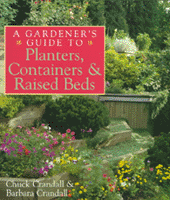|
The arrival of warm weather signals that it
is time to begin preparations for working in the garden.
Some of us are always on the lookout for new and creative
ideas for growing plants and flowers.
Others consider alternative methods of gardening to enhance
our living space or beautify a smaller area.
Chuck and Barbara Crandall's book “A Gardener's Guide To
Planters, Containers, and Raised Beds” is an enlightening look
at how to spice up your surroundings with exciting garden
projects. It covers
three types of projects that offer ideas for those who do not have
adequate yard space for an in-ground garden.

The book opens with a chapter on built-in and
portable planters. Planters
are essentially soil containers that allow almost any type of
plant to be grown in them. They
are usually permanent structures and are designed to complement
the surrounding space. Planters
can be constructed of any material, but are generally made from
the same materials as the house or patio.
The book’s directions on building planters are useful,
especially the passage on the best protective finishes for wood
planters. The
chapter on containers describes the conventional types that can be
placed in small spaces, on steps or stairs, or in different
designs and patterns. Containers
can include pots, pans, bowls, troughs and those that hang.
Some of the more unconventional containers include pipes,
flue tiles, hollowed-out logs, baskets, tubs and barrels.
The authors remind us that the secret to a successful
container garden is good drainage.
Excess water at the bottom of the container that is not
expelled can cause root decay and kill the plant.

The chapter on designing and building raised garden
beds is among the most interesting in the book. Although the process of planning and building a raised bed
can be challenging, the authors have thoroughly covered the
subject. Raised beds
have many advantages, especially when they are used to decorate a
small space. They are
also ideal for landscape design, traffic direction or for
gardeners with physical disabilities.
Raised beds can be the perfect remedy when the native soil
is unsuitable for growing. In
addition to some handy tips on raised-bed construction, the
authors also discuss the necessity of a good irrigation system.
(To
top of second column)
|

After discussing the different types of containers,
the focus of the book shifts to the plants, trees and shrubs that
grow in above-ground gardens.
This comprehensive section explains the kinds of plants
that are best suited for a particular garden.
The container gardening guide includes the plant’s name,
height, blooms, color and days to germination.
Other important information includes when to plant,
propagation, planting depth, exposure and moisture.

The following chapter describes the different
fertilizers and soil mixes needed to grow in a contained area.
An easy-to-read explanation on organic and chemical
fertilizers is the key to success.
The chapter on the proper methods of planting offers
helpful hints on winter care, pests and diseases, and the use of
organic pesticides. A
concluding chapter offers advice on “staying legal,” or
working within existing building permits and variances.
It also provides information on working with professional
landscape designers, architects and contractors.

“A
Gardener’s Guide To Planters, Containers, and Raised Beds” is
an informative and colorful guide that will inspire any gardener
with project ideas for years to come.
The book is lavishly illustrated with numerous photographs
and drawings of above-ground projects.
Both the serious and weekend gardener will be comfortable
with the authors’ presentation and their no-nonsense style of
writing. This book is
recommended to anyone who gardens or is contemplating a garden
project using above-ground containers.
For
more information, visit the library at 725 Pekin St. or call
217-732-8878.
[Richard Sumrall, Lincoln Public Library
District]
|

